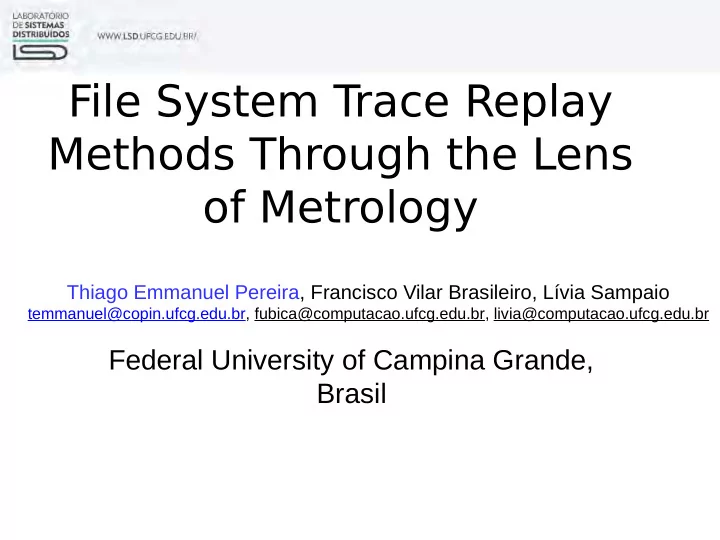

File System Trace Replay Methods Through the Lens of Metrology Thiago Emmanuel Pereira, Francisco Vilar Brasileiro, Lívia Sampaio temmanuel@copin.ufcg.edu.br, fubica@computacao.ufcg.edu.br, livia@computacao.ufcg.edu.br Federal University of Campina Grande, Brasil
Very popular but ... • Many ad hoc trace replay tools – no description about their design and implementation • Impossible to reproduce results. "How to do this accurately is still an open question, and the best we can do right now is take results with a degree of skepticism” - Traeger, A., Zadok, E., Joukov, N., & Wright, C. P. (2008). A nine year study of file system and storage benchmarking. ACM Transactions on Storage (TOS)
Before creating new methods, how good are current trace based methods?
Our take A metrology case study
Our take A metrology case study Single-laboratory
Our take A metrology case study Single-laboratory Inter-laboratories Different operators Different instruments Different environment
Our take A metrology case study Single-laboratory Inter-laboratories Different operators Different instruments Different environment
Single-lab testing 1. Defjne the measurand ● The quantity intended to be measured 2. Specify the measurement procedure 3. Identify the uncertainty sources 4. Conduct the measurement characterization ● In terms of bias, precision, sensitivity, resolution, etc. 5. Perform the calibration (or mitigation of measurement errors) 6. Calculate the measurement uncertainty ● An interval [y – u, y + u] within the true value of measurand y are expected to be.
Measurand File system response time
Measurement procedure Instruments ARTC replayer (compilation-based) TBBT replayer (event-based) 1.Weiss, Zev, et al . "Root: Replaying multithreaded traces with resource- oriented ordering." SOSP . ACM, 2013. 2.Zhu, Ningning, Jiawu Chen, and Tzi-Cker Chiueh. "TBBT: scalable and accurate trace replay for fjle server evaluation." FAST,2005.
ARTC Replayer shared library C code ARTC compiler C compiler ARTC replayer trace 1.Weiss, Zev, et al . "Root: Replaying multithreaded traces with resource- oriented ordering." SOSP . ACM, 2013.
TBBT Replayer Based on TBBT design, running as a real time process to be less sensitive formatter TBBT trace trace 1.Zhu, Ningning, Jiawu Chen, and Tzi-Cker Chiueh. "TBBT: scalable and accurate trace replay for fjle server evaluation." FAST,2005. 2.T arihi, Mojtaba, Hossein Asadi, and Hamid Sarbazi-Azad. "DiskAccel: Accelerating Disk-Based Experiments by Representative Sampling." SIGMETRICS , 2015.
Uncertainty sources
Characterization ARTC trace capture Workload Measurement TBBT
Characterization ARTC trace capture Workload Measurement TBBT Reference values
Characterization • Microbenchmark (5k ops, 4k chunks, [1-4] threads) • Random read (RR), Random write (RW) • Sequential read (SR), Sequential write (SW) • Filebench fjleserver workload ARTC trace capture Workload Measurement TBBT Reference values
Characterization Microbenchmark
Bias characterization
Bias characterization
Bias characterization
TBBT improvements
TBBT improvements TBBT coordinator overhead TBBT coordinator overhead
TBBT improvements TBBT coordinator overhead Real time scheduler TBBT coordinator overhead
Uncertainty Workload TBBT ARTC Random read 22579.0 ± 2.4% (22891.6 ± 4.8%) 22243.5 ± 1.8% Random write 22946.1 ± 3.2% (24807.6 ± 18%) 23076.0 ± 4.1% Sequential read 4.0 ± 32.9% (7.8 ± 253%) 3.7 ± 18.6% Sequential write 105.6 ± 1.3% (107.7 ± 4.2%) 105.8 ± 0.6%
Uncertainty Before TBBT improvements ARTC is a clear winner Workload TBBT ARTC Random read 22579.0 ± 2.4% (22891.6 ± 4.8%) 22243.5 ± 1.8% Random write 22946.1 ± 3.2% (24807.6 ± 18%) 23076.0 ± 4.1% Sequential read 4.0 ± 32.9% (7.8 ± 253%) 3.7 ± 18.6% Sequential write 105.6 ± 1.3% (107.7 ± 4.2%) 105.8 ± 0.6%
Uncertainty TBBT improvements are affective Workload TBBT ARTC Random read 22579.0 ± 2.4% (22891.6 ± 4.8%) 22243.5 ± 1.8% Random write 22946.1 ± 3.2% (24807.6 ± 18%) 23076.0 ± 4.1% Sequential read 4.0 ± 32.9% (7.8 ± 253%) 3.7 ± 18.6% Sequential write 105.6 ± 1.3% (107.7 ± 4.2%) 105.8 ± 0.6%
Uncertainty How to choose between replayers? Workload TBBT ARTC Random read 22579.0 ± 2.4% (22891.6 ± 4.8%) 22243.5 ± 1.8% Random write 22946.1 ± 3.2% (24807.6 ± 18%) 23076.0 ± 4.1% Sequential read 4.0 ± 32.9% (7.8 ± 253%) 3.7 ± 18.6% Sequential write 105.6 ± 1.3% (107.7 ± 4.2%) 105.8 ± 0.6%
Characterization Filebench fjleserver workload
Characterization Filebench fjleserver workload • 4 threads • creat, delete, append, read, write, stat • variable fjle sizes • Wholefjle read and write
Uncertainty TBBT ARTC Reference Read 20.73 ± 118.27% 27.21 ± 92.72% 50.72 Write 50.45 ± 79.81% 69.79 ± 33.79% 83.95
Uncertainty TBBT ARTC Reference Read 20.73 ± 118.27% 27.21 ± 92.72% 50.72 Write 50.45 ± 79.81% 69.79 ± 33.79% 83.95 Replayed response time appears better than reference TBBT and ARTC memory footprints are smaller than filebench footprint, thus more cache hits
Uncertainty TBBT ARTC Reference Read 20.73 ± 118.27% 27.21 ± 92.72% 50.72 Write 50.45 ± 79.81% 69.79 ± 33.79% 83.95 TBBT response time appears better than ARTC response time
Uncertainty Replayers are not able to match captured workload concurrency
Conclusions Metrology can help: • Choosing the best instrument for the job (based on the measurement uncertainty) • The TBBT replayer, in some cases, is equivalent to the ARTC replayer. • Improving tools and best practices • Event-based replayer needs improvement • Changes in OS scheduler policy may affect sensitive metrics. • Spotting uncertainty sources • Differences in experimental environment, such as the amount of available memory, are likely to hurt reproducibility.
Recommend
More recommend